Reflective Analysis of Leadership
VerifiedAdded on 2022/04/16
|12
|4255
|33
AI Summary
This paper seeks to examine and apply some ideas gained through leadership journal articles and classroom exercises to my leadership experience, primarily in the setting of organisations. My leadership experience primarily comes from my time as an audit assistant supervisor in an accounting company, but it also relates to some of the responsibilities I now have in my current position as group accountant, like managing a project to introduce a new system.
Contribute Materials
Your contribution can guide someone’s learning journey. Share your
documents today.
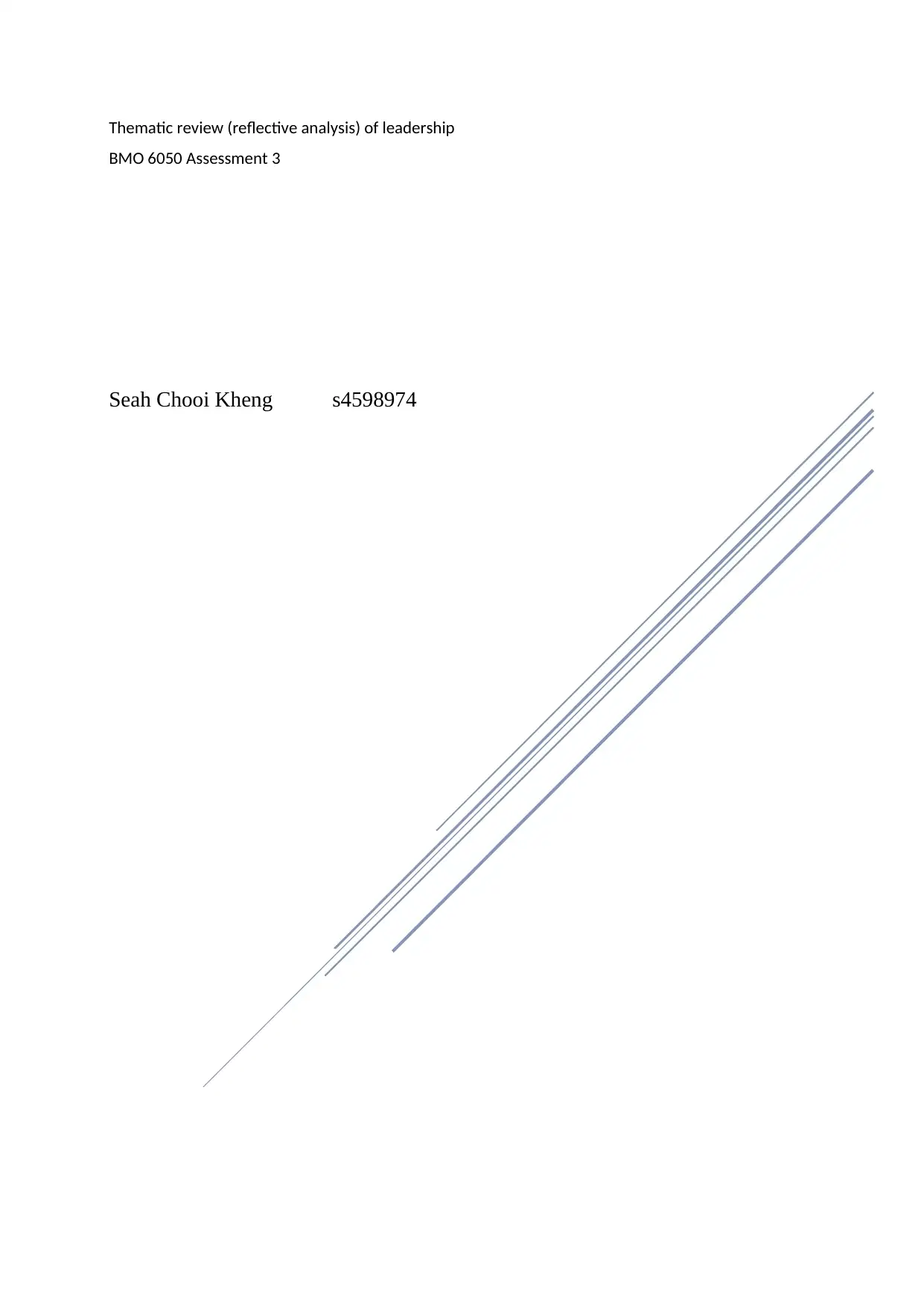
Thematic review (reflective analysis) of leadership
BMO 6050 Assessment 3
Seah Chooi Kheng s4598974
BMO 6050 Assessment 3
Seah Chooi Kheng s4598974
Secure Best Marks with AI Grader
Need help grading? Try our AI Grader for instant feedback on your assignments.
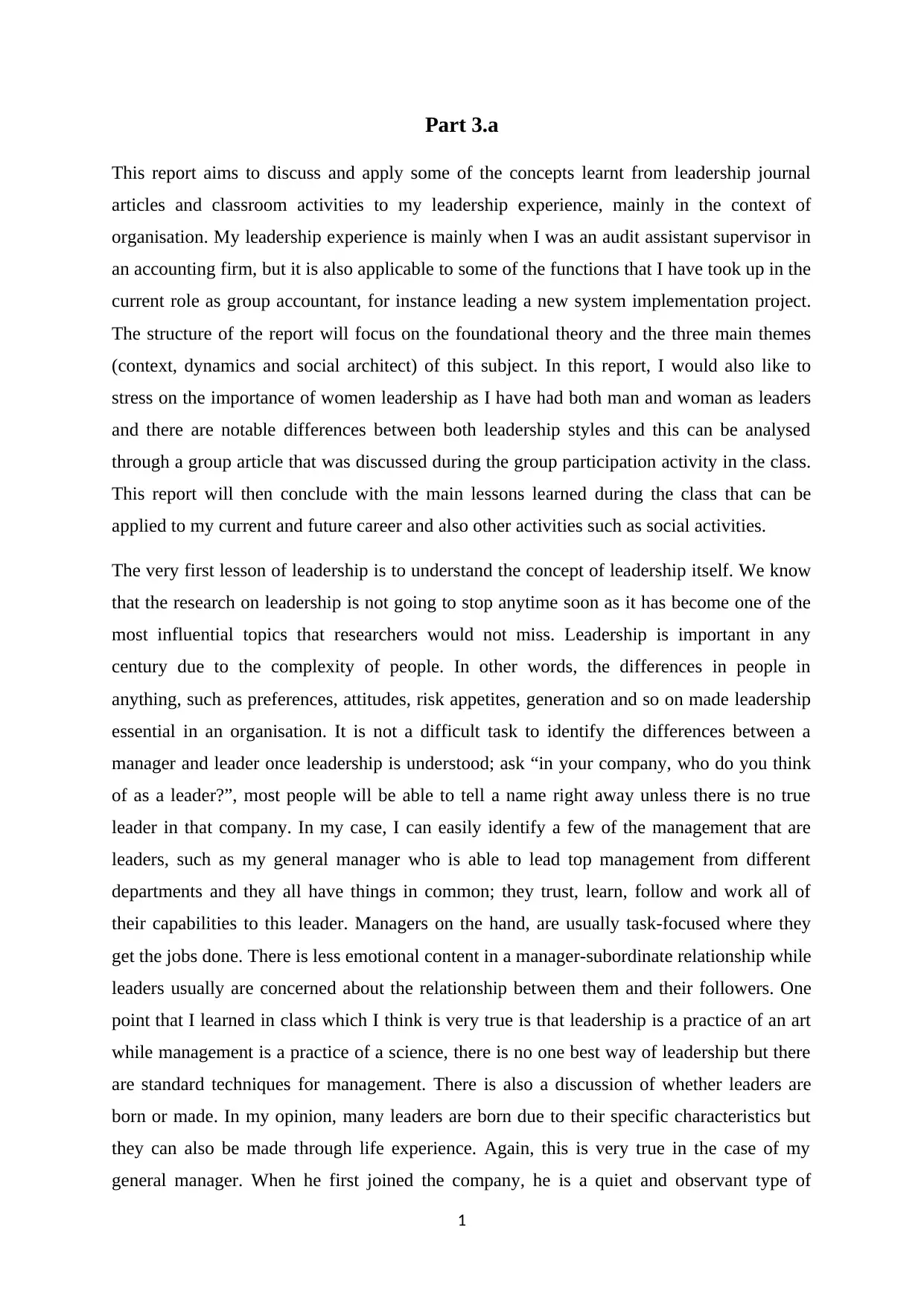
Part 3.a
This report aims to discuss and apply some of the concepts learnt from leadership journal
articles and classroom activities to my leadership experience, mainly in the context of
organisation. My leadership experience is mainly when I was an audit assistant supervisor in
an accounting firm, but it is also applicable to some of the functions that I have took up in the
current role as group accountant, for instance leading a new system implementation project.
The structure of the report will focus on the foundational theory and the three main themes
(context, dynamics and social architect) of this subject. In this report, I would also like to
stress on the importance of women leadership as I have had both man and woman as leaders
and there are notable differences between both leadership styles and this can be analysed
through a group article that was discussed during the group participation activity in the class.
This report will then conclude with the main lessons learned during the class that can be
applied to my current and future career and also other activities such as social activities.
The very first lesson of leadership is to understand the concept of leadership itself. We know
that the research on leadership is not going to stop anytime soon as it has become one of the
most influential topics that researchers would not miss. Leadership is important in any
century due to the complexity of people. In other words, the differences in people in
anything, such as preferences, attitudes, risk appetites, generation and so on made leadership
essential in an organisation. It is not a difficult task to identify the differences between a
manager and leader once leadership is understood; ask “in your company, who do you think
of as a leader?”, most people will be able to tell a name right away unless there is no true
leader in that company. In my case, I can easily identify a few of the management that are
leaders, such as my general manager who is able to lead top management from different
departments and they all have things in common; they trust, learn, follow and work all of
their capabilities to this leader. Managers on the hand, are usually task-focused where they
get the jobs done. There is less emotional content in a manager-subordinate relationship while
leaders usually are concerned about the relationship between them and their followers. One
point that I learned in class which I think is very true is that leadership is a practice of an art
while management is a practice of a science, there is no one best way of leadership but there
are standard techniques for management. There is also a discussion of whether leaders are
born or made. In my opinion, many leaders are born due to their specific characteristics but
they can also be made through life experience. Again, this is very true in the case of my
general manager. When he first joined the company, he is a quiet and observant type of
1
This report aims to discuss and apply some of the concepts learnt from leadership journal
articles and classroom activities to my leadership experience, mainly in the context of
organisation. My leadership experience is mainly when I was an audit assistant supervisor in
an accounting firm, but it is also applicable to some of the functions that I have took up in the
current role as group accountant, for instance leading a new system implementation project.
The structure of the report will focus on the foundational theory and the three main themes
(context, dynamics and social architect) of this subject. In this report, I would also like to
stress on the importance of women leadership as I have had both man and woman as leaders
and there are notable differences between both leadership styles and this can be analysed
through a group article that was discussed during the group participation activity in the class.
This report will then conclude with the main lessons learned during the class that can be
applied to my current and future career and also other activities such as social activities.
The very first lesson of leadership is to understand the concept of leadership itself. We know
that the research on leadership is not going to stop anytime soon as it has become one of the
most influential topics that researchers would not miss. Leadership is important in any
century due to the complexity of people. In other words, the differences in people in
anything, such as preferences, attitudes, risk appetites, generation and so on made leadership
essential in an organisation. It is not a difficult task to identify the differences between a
manager and leader once leadership is understood; ask “in your company, who do you think
of as a leader?”, most people will be able to tell a name right away unless there is no true
leader in that company. In my case, I can easily identify a few of the management that are
leaders, such as my general manager who is able to lead top management from different
departments and they all have things in common; they trust, learn, follow and work all of
their capabilities to this leader. Managers on the hand, are usually task-focused where they
get the jobs done. There is less emotional content in a manager-subordinate relationship while
leaders usually are concerned about the relationship between them and their followers. One
point that I learned in class which I think is very true is that leadership is a practice of an art
while management is a practice of a science, there is no one best way of leadership but there
are standard techniques for management. There is also a discussion of whether leaders are
born or made. In my opinion, many leaders are born due to their specific characteristics but
they can also be made through life experience. Again, this is very true in the case of my
general manager. When he first joined the company, he is a quiet and observant type of
1
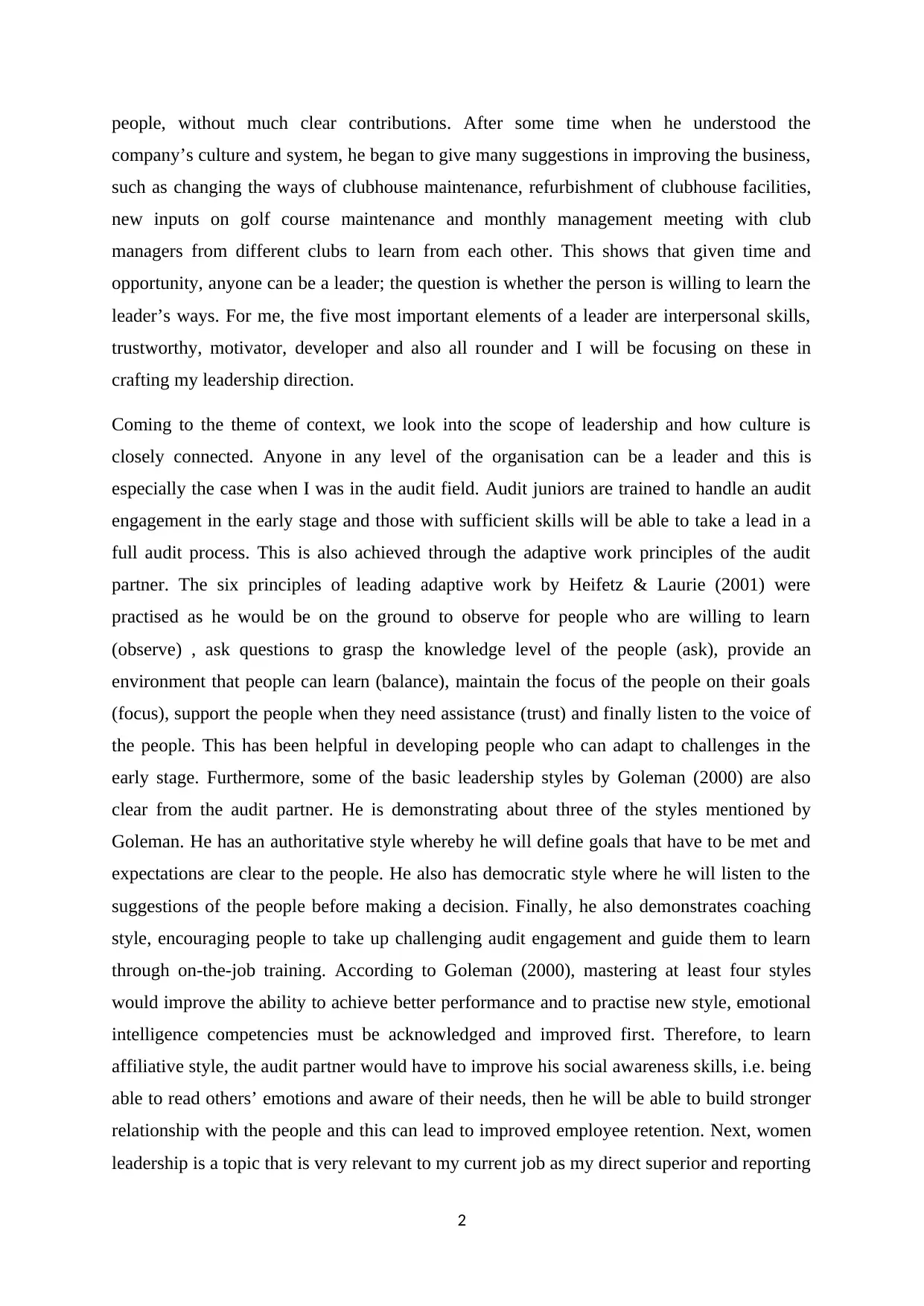
people, without much clear contributions. After some time when he understood the
company’s culture and system, he began to give many suggestions in improving the business,
such as changing the ways of clubhouse maintenance, refurbishment of clubhouse facilities,
new inputs on golf course maintenance and monthly management meeting with club
managers from different clubs to learn from each other. This shows that given time and
opportunity, anyone can be a leader; the question is whether the person is willing to learn the
leader’s ways. For me, the five most important elements of a leader are interpersonal skills,
trustworthy, motivator, developer and also all rounder and I will be focusing on these in
crafting my leadership direction.
Coming to the theme of context, we look into the scope of leadership and how culture is
closely connected. Anyone in any level of the organisation can be a leader and this is
especially the case when I was in the audit field. Audit juniors are trained to handle an audit
engagement in the early stage and those with sufficient skills will be able to take a lead in a
full audit process. This is also achieved through the adaptive work principles of the audit
partner. The six principles of leading adaptive work by Heifetz & Laurie (2001) were
practised as he would be on the ground to observe for people who are willing to learn
(observe) , ask questions to grasp the knowledge level of the people (ask), provide an
environment that people can learn (balance), maintain the focus of the people on their goals
(focus), support the people when they need assistance (trust) and finally listen to the voice of
the people. This has been helpful in developing people who can adapt to challenges in the
early stage. Furthermore, some of the basic leadership styles by Goleman (2000) are also
clear from the audit partner. He is demonstrating about three of the styles mentioned by
Goleman. He has an authoritative style whereby he will define goals that have to be met and
expectations are clear to the people. He also has democratic style where he will listen to the
suggestions of the people before making a decision. Finally, he also demonstrates coaching
style, encouraging people to take up challenging audit engagement and guide them to learn
through on-the-job training. According to Goleman (2000), mastering at least four styles
would improve the ability to achieve better performance and to practise new style, emotional
intelligence competencies must be acknowledged and improved first. Therefore, to learn
affiliative style, the audit partner would have to improve his social awareness skills, i.e. being
able to read others’ emotions and aware of their needs, then he will be able to build stronger
relationship with the people and this can lead to improved employee retention. Next, women
leadership is a topic that is very relevant to my current job as my direct superior and reporting
2
company’s culture and system, he began to give many suggestions in improving the business,
such as changing the ways of clubhouse maintenance, refurbishment of clubhouse facilities,
new inputs on golf course maintenance and monthly management meeting with club
managers from different clubs to learn from each other. This shows that given time and
opportunity, anyone can be a leader; the question is whether the person is willing to learn the
leader’s ways. For me, the five most important elements of a leader are interpersonal skills,
trustworthy, motivator, developer and also all rounder and I will be focusing on these in
crafting my leadership direction.
Coming to the theme of context, we look into the scope of leadership and how culture is
closely connected. Anyone in any level of the organisation can be a leader and this is
especially the case when I was in the audit field. Audit juniors are trained to handle an audit
engagement in the early stage and those with sufficient skills will be able to take a lead in a
full audit process. This is also achieved through the adaptive work principles of the audit
partner. The six principles of leading adaptive work by Heifetz & Laurie (2001) were
practised as he would be on the ground to observe for people who are willing to learn
(observe) , ask questions to grasp the knowledge level of the people (ask), provide an
environment that people can learn (balance), maintain the focus of the people on their goals
(focus), support the people when they need assistance (trust) and finally listen to the voice of
the people. This has been helpful in developing people who can adapt to challenges in the
early stage. Furthermore, some of the basic leadership styles by Goleman (2000) are also
clear from the audit partner. He is demonstrating about three of the styles mentioned by
Goleman. He has an authoritative style whereby he will define goals that have to be met and
expectations are clear to the people. He also has democratic style where he will listen to the
suggestions of the people before making a decision. Finally, he also demonstrates coaching
style, encouraging people to take up challenging audit engagement and guide them to learn
through on-the-job training. According to Goleman (2000), mastering at least four styles
would improve the ability to achieve better performance and to practise new style, emotional
intelligence competencies must be acknowledged and improved first. Therefore, to learn
affiliative style, the audit partner would have to improve his social awareness skills, i.e. being
able to read others’ emotions and aware of their needs, then he will be able to build stronger
relationship with the people and this can lead to improved employee retention. Next, women
leadership is a topic that is very relevant to my current job as my direct superior and reporting
2
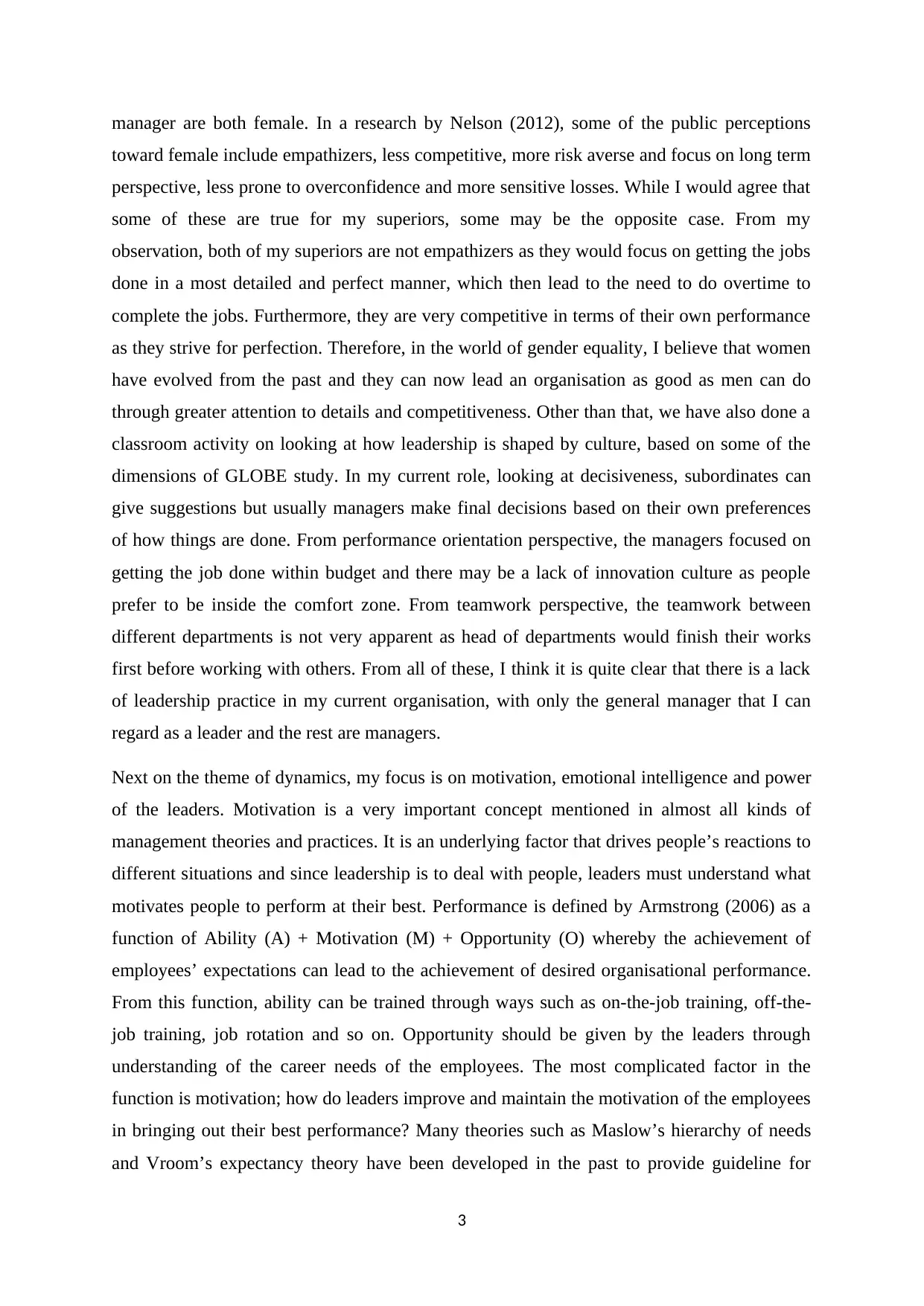
manager are both female. In a research by Nelson (2012), some of the public perceptions
toward female include empathizers, less competitive, more risk averse and focus on long term
perspective, less prone to overconfidence and more sensitive losses. While I would agree that
some of these are true for my superiors, some may be the opposite case. From my
observation, both of my superiors are not empathizers as they would focus on getting the jobs
done in a most detailed and perfect manner, which then lead to the need to do overtime to
complete the jobs. Furthermore, they are very competitive in terms of their own performance
as they strive for perfection. Therefore, in the world of gender equality, I believe that women
have evolved from the past and they can now lead an organisation as good as men can do
through greater attention to details and competitiveness. Other than that, we have also done a
classroom activity on looking at how leadership is shaped by culture, based on some of the
dimensions of GLOBE study. In my current role, looking at decisiveness, subordinates can
give suggestions but usually managers make final decisions based on their own preferences
of how things are done. From performance orientation perspective, the managers focused on
getting the job done within budget and there may be a lack of innovation culture as people
prefer to be inside the comfort zone. From teamwork perspective, the teamwork between
different departments is not very apparent as head of departments would finish their works
first before working with others. From all of these, I think it is quite clear that there is a lack
of leadership practice in my current organisation, with only the general manager that I can
regard as a leader and the rest are managers.
Next on the theme of dynamics, my focus is on motivation, emotional intelligence and power
of the leaders. Motivation is a very important concept mentioned in almost all kinds of
management theories and practices. It is an underlying factor that drives people’s reactions to
different situations and since leadership is to deal with people, leaders must understand what
motivates people to perform at their best. Performance is defined by Armstrong (2006) as a
function of Ability (A) + Motivation (M) + Opportunity (O) whereby the achievement of
employees’ expectations can lead to the achievement of desired organisational performance.
From this function, ability can be trained through ways such as on-the-job training, off-the-
job training, job rotation and so on. Opportunity should be given by the leaders through
understanding of the career needs of the employees. The most complicated factor in the
function is motivation; how do leaders improve and maintain the motivation of the employees
in bringing out their best performance? Many theories such as Maslow’s hierarchy of needs
and Vroom’s expectancy theory have been developed in the past to provide guideline for
3
toward female include empathizers, less competitive, more risk averse and focus on long term
perspective, less prone to overconfidence and more sensitive losses. While I would agree that
some of these are true for my superiors, some may be the opposite case. From my
observation, both of my superiors are not empathizers as they would focus on getting the jobs
done in a most detailed and perfect manner, which then lead to the need to do overtime to
complete the jobs. Furthermore, they are very competitive in terms of their own performance
as they strive for perfection. Therefore, in the world of gender equality, I believe that women
have evolved from the past and they can now lead an organisation as good as men can do
through greater attention to details and competitiveness. Other than that, we have also done a
classroom activity on looking at how leadership is shaped by culture, based on some of the
dimensions of GLOBE study. In my current role, looking at decisiveness, subordinates can
give suggestions but usually managers make final decisions based on their own preferences
of how things are done. From performance orientation perspective, the managers focused on
getting the job done within budget and there may be a lack of innovation culture as people
prefer to be inside the comfort zone. From teamwork perspective, the teamwork between
different departments is not very apparent as head of departments would finish their works
first before working with others. From all of these, I think it is quite clear that there is a lack
of leadership practice in my current organisation, with only the general manager that I can
regard as a leader and the rest are managers.
Next on the theme of dynamics, my focus is on motivation, emotional intelligence and power
of the leaders. Motivation is a very important concept mentioned in almost all kinds of
management theories and practices. It is an underlying factor that drives people’s reactions to
different situations and since leadership is to deal with people, leaders must understand what
motivates people to perform at their best. Performance is defined by Armstrong (2006) as a
function of Ability (A) + Motivation (M) + Opportunity (O) whereby the achievement of
employees’ expectations can lead to the achievement of desired organisational performance.
From this function, ability can be trained through ways such as on-the-job training, off-the-
job training, job rotation and so on. Opportunity should be given by the leaders through
understanding of the career needs of the employees. The most complicated factor in the
function is motivation; how do leaders improve and maintain the motivation of the employees
in bringing out their best performance? Many theories such as Maslow’s hierarchy of needs
and Vroom’s expectancy theory have been developed in the past to provide guideline for
3
Secure Best Marks with AI Grader
Need help grading? Try our AI Grader for instant feedback on your assignments.
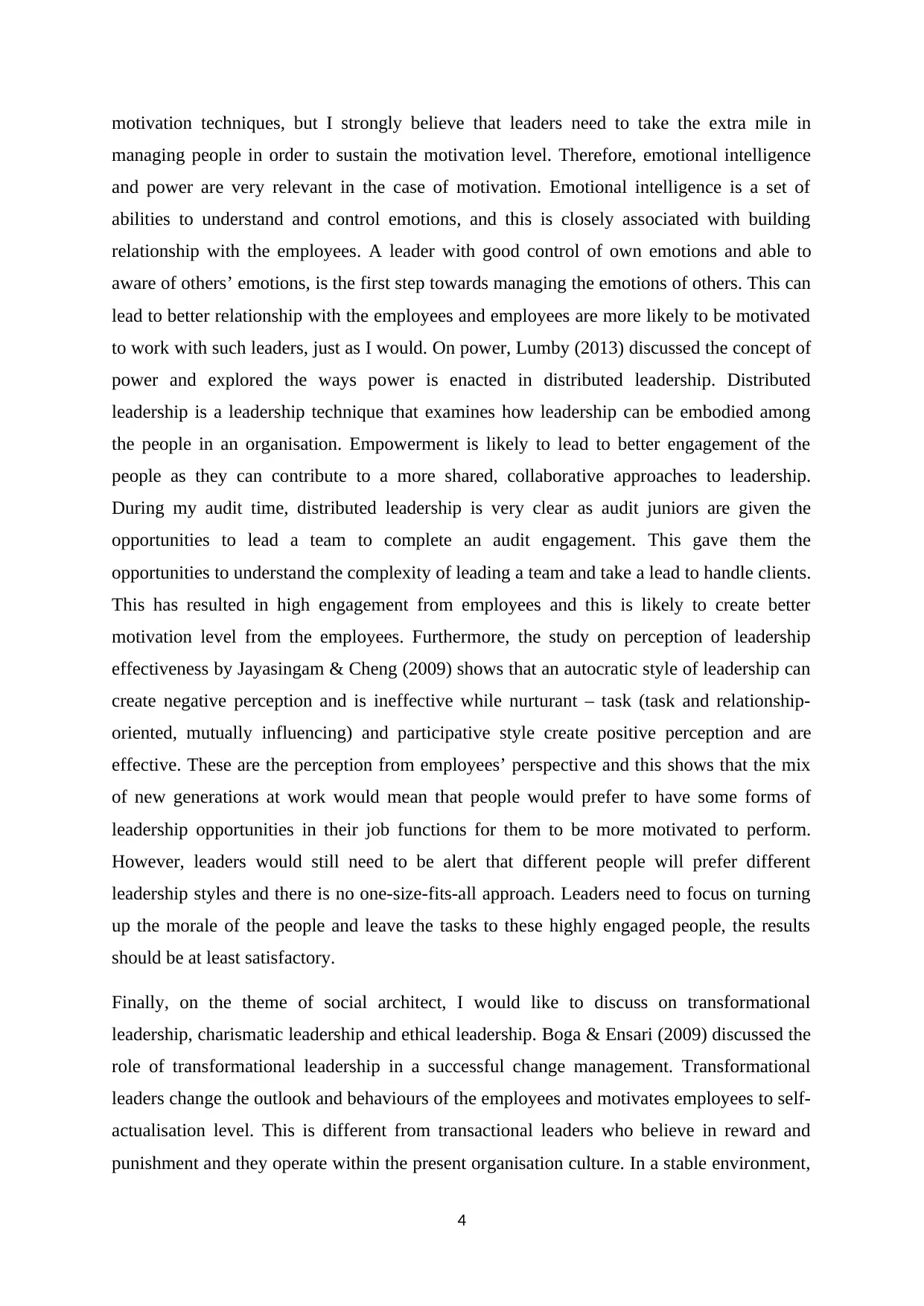
motivation techniques, but I strongly believe that leaders need to take the extra mile in
managing people in order to sustain the motivation level. Therefore, emotional intelligence
and power are very relevant in the case of motivation. Emotional intelligence is a set of
abilities to understand and control emotions, and this is closely associated with building
relationship with the employees. A leader with good control of own emotions and able to
aware of others’ emotions, is the first step towards managing the emotions of others. This can
lead to better relationship with the employees and employees are more likely to be motivated
to work with such leaders, just as I would. On power, Lumby (2013) discussed the concept of
power and explored the ways power is enacted in distributed leadership. Distributed
leadership is a leadership technique that examines how leadership can be embodied among
the people in an organisation. Empowerment is likely to lead to better engagement of the
people as they can contribute to a more shared, collaborative approaches to leadership.
During my audit time, distributed leadership is very clear as audit juniors are given the
opportunities to lead a team to complete an audit engagement. This gave them the
opportunities to understand the complexity of leading a team and take a lead to handle clients.
This has resulted in high engagement from employees and this is likely to create better
motivation level from the employees. Furthermore, the study on perception of leadership
effectiveness by Jayasingam & Cheng (2009) shows that an autocratic style of leadership can
create negative perception and is ineffective while nurturant – task (task and relationship-
oriented, mutually influencing) and participative style create positive perception and are
effective. These are the perception from employees’ perspective and this shows that the mix
of new generations at work would mean that people would prefer to have some forms of
leadership opportunities in their job functions for them to be more motivated to perform.
However, leaders would still need to be alert that different people will prefer different
leadership styles and there is no one-size-fits-all approach. Leaders need to focus on turning
up the morale of the people and leave the tasks to these highly engaged people, the results
should be at least satisfactory.
Finally, on the theme of social architect, I would like to discuss on transformational
leadership, charismatic leadership and ethical leadership. Boga & Ensari (2009) discussed the
role of transformational leadership in a successful change management. Transformational
leaders change the outlook and behaviours of the employees and motivates employees to self-
actualisation level. This is different from transactional leaders who believe in reward and
punishment and they operate within the present organisation culture. In a stable environment,
4
managing people in order to sustain the motivation level. Therefore, emotional intelligence
and power are very relevant in the case of motivation. Emotional intelligence is a set of
abilities to understand and control emotions, and this is closely associated with building
relationship with the employees. A leader with good control of own emotions and able to
aware of others’ emotions, is the first step towards managing the emotions of others. This can
lead to better relationship with the employees and employees are more likely to be motivated
to work with such leaders, just as I would. On power, Lumby (2013) discussed the concept of
power and explored the ways power is enacted in distributed leadership. Distributed
leadership is a leadership technique that examines how leadership can be embodied among
the people in an organisation. Empowerment is likely to lead to better engagement of the
people as they can contribute to a more shared, collaborative approaches to leadership.
During my audit time, distributed leadership is very clear as audit juniors are given the
opportunities to lead a team to complete an audit engagement. This gave them the
opportunities to understand the complexity of leading a team and take a lead to handle clients.
This has resulted in high engagement from employees and this is likely to create better
motivation level from the employees. Furthermore, the study on perception of leadership
effectiveness by Jayasingam & Cheng (2009) shows that an autocratic style of leadership can
create negative perception and is ineffective while nurturant – task (task and relationship-
oriented, mutually influencing) and participative style create positive perception and are
effective. These are the perception from employees’ perspective and this shows that the mix
of new generations at work would mean that people would prefer to have some forms of
leadership opportunities in their job functions for them to be more motivated to perform.
However, leaders would still need to be alert that different people will prefer different
leadership styles and there is no one-size-fits-all approach. Leaders need to focus on turning
up the morale of the people and leave the tasks to these highly engaged people, the results
should be at least satisfactory.
Finally, on the theme of social architect, I would like to discuss on transformational
leadership, charismatic leadership and ethical leadership. Boga & Ensari (2009) discussed the
role of transformational leadership in a successful change management. Transformational
leaders change the outlook and behaviours of the employees and motivates employees to self-
actualisation level. This is different from transactional leaders who believe in reward and
punishment and they operate within the present organisation culture. In a stable environment,
4
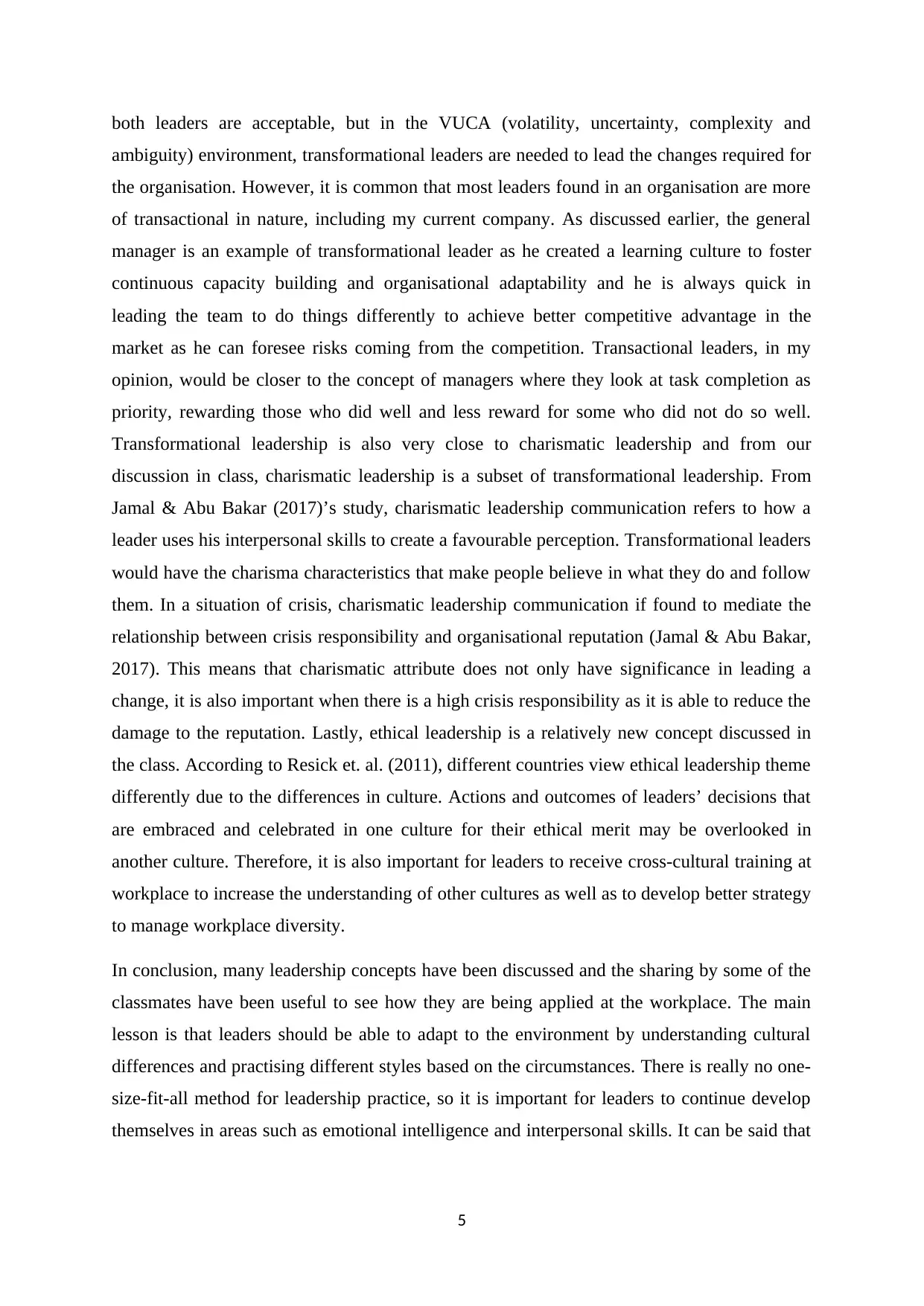
both leaders are acceptable, but in the VUCA (volatility, uncertainty, complexity and
ambiguity) environment, transformational leaders are needed to lead the changes required for
the organisation. However, it is common that most leaders found in an organisation are more
of transactional in nature, including my current company. As discussed earlier, the general
manager is an example of transformational leader as he created a learning culture to foster
continuous capacity building and organisational adaptability and he is always quick in
leading the team to do things differently to achieve better competitive advantage in the
market as he can foresee risks coming from the competition. Transactional leaders, in my
opinion, would be closer to the concept of managers where they look at task completion as
priority, rewarding those who did well and less reward for some who did not do so well.
Transformational leadership is also very close to charismatic leadership and from our
discussion in class, charismatic leadership is a subset of transformational leadership. From
Jamal & Abu Bakar (2017)’s study, charismatic leadership communication refers to how a
leader uses his interpersonal skills to create a favourable perception. Transformational leaders
would have the charisma characteristics that make people believe in what they do and follow
them. In a situation of crisis, charismatic leadership communication if found to mediate the
relationship between crisis responsibility and organisational reputation (Jamal & Abu Bakar,
2017). This means that charismatic attribute does not only have significance in leading a
change, it is also important when there is a high crisis responsibility as it is able to reduce the
damage to the reputation. Lastly, ethical leadership is a relatively new concept discussed in
the class. According to Resick et. al. (2011), different countries view ethical leadership theme
differently due to the differences in culture. Actions and outcomes of leaders’ decisions that
are embraced and celebrated in one culture for their ethical merit may be overlooked in
another culture. Therefore, it is also important for leaders to receive cross-cultural training at
workplace to increase the understanding of other cultures as well as to develop better strategy
to manage workplace diversity.
In conclusion, many leadership concepts have been discussed and the sharing by some of the
classmates have been useful to see how they are being applied at the workplace. The main
lesson is that leaders should be able to adapt to the environment by understanding cultural
differences and practising different styles based on the circumstances. There is really no one-
size-fit-all method for leadership practice, so it is important for leaders to continue develop
themselves in areas such as emotional intelligence and interpersonal skills. It can be said that
5
ambiguity) environment, transformational leaders are needed to lead the changes required for
the organisation. However, it is common that most leaders found in an organisation are more
of transactional in nature, including my current company. As discussed earlier, the general
manager is an example of transformational leader as he created a learning culture to foster
continuous capacity building and organisational adaptability and he is always quick in
leading the team to do things differently to achieve better competitive advantage in the
market as he can foresee risks coming from the competition. Transactional leaders, in my
opinion, would be closer to the concept of managers where they look at task completion as
priority, rewarding those who did well and less reward for some who did not do so well.
Transformational leadership is also very close to charismatic leadership and from our
discussion in class, charismatic leadership is a subset of transformational leadership. From
Jamal & Abu Bakar (2017)’s study, charismatic leadership communication refers to how a
leader uses his interpersonal skills to create a favourable perception. Transformational leaders
would have the charisma characteristics that make people believe in what they do and follow
them. In a situation of crisis, charismatic leadership communication if found to mediate the
relationship between crisis responsibility and organisational reputation (Jamal & Abu Bakar,
2017). This means that charismatic attribute does not only have significance in leading a
change, it is also important when there is a high crisis responsibility as it is able to reduce the
damage to the reputation. Lastly, ethical leadership is a relatively new concept discussed in
the class. According to Resick et. al. (2011), different countries view ethical leadership theme
differently due to the differences in culture. Actions and outcomes of leaders’ decisions that
are embraced and celebrated in one culture for their ethical merit may be overlooked in
another culture. Therefore, it is also important for leaders to receive cross-cultural training at
workplace to increase the understanding of other cultures as well as to develop better strategy
to manage workplace diversity.
In conclusion, many leadership concepts have been discussed and the sharing by some of the
classmates have been useful to see how they are being applied at the workplace. The main
lesson is that leaders should be able to adapt to the environment by understanding cultural
differences and practising different styles based on the circumstances. There is really no one-
size-fit-all method for leadership practice, so it is important for leaders to continue develop
themselves in areas such as emotional intelligence and interpersonal skills. It can be said that
5
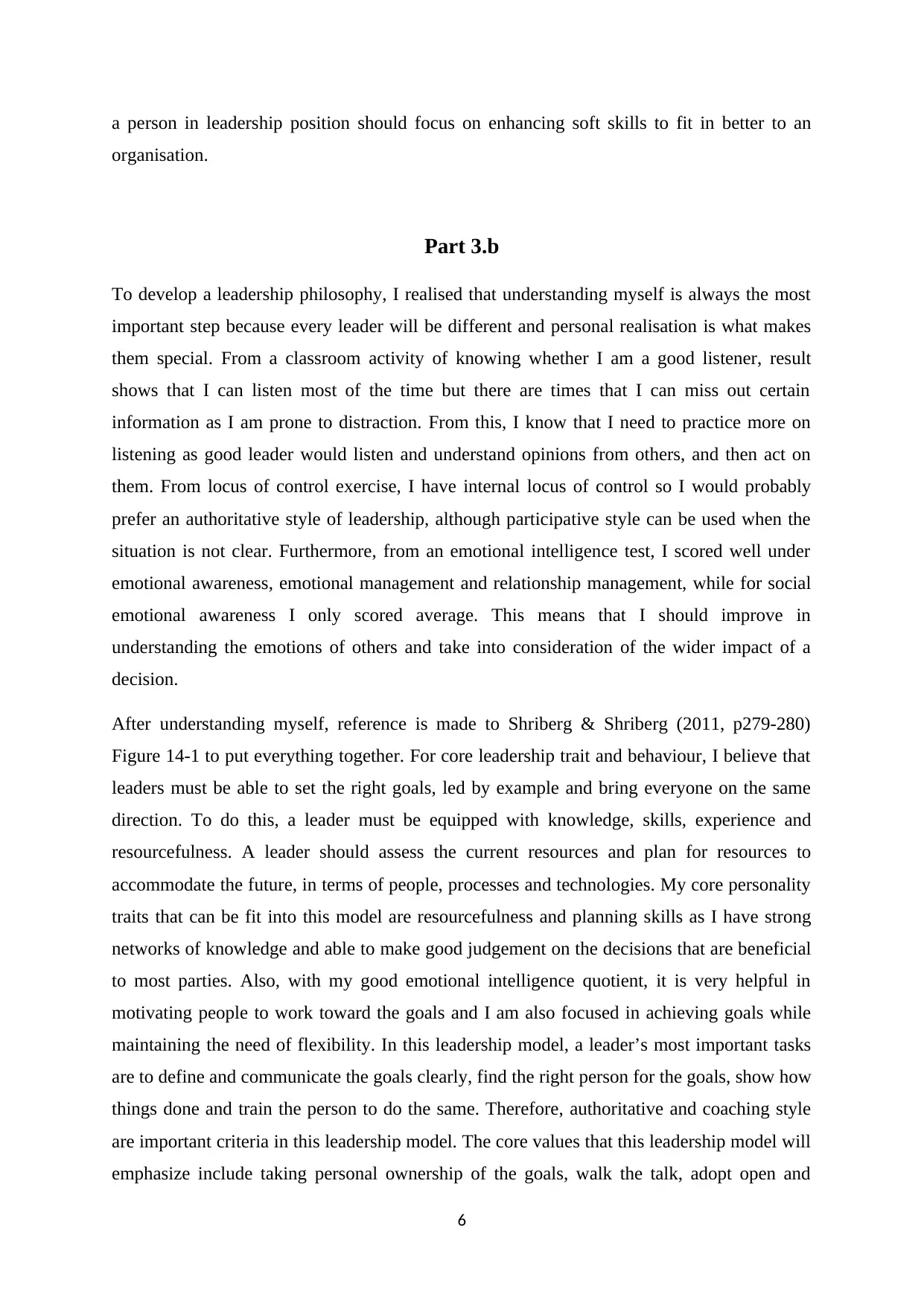
a person in leadership position should focus on enhancing soft skills to fit in better to an
organisation.
Part 3.b
To develop a leadership philosophy, I realised that understanding myself is always the most
important step because every leader will be different and personal realisation is what makes
them special. From a classroom activity of knowing whether I am a good listener, result
shows that I can listen most of the time but there are times that I can miss out certain
information as I am prone to distraction. From this, I know that I need to practice more on
listening as good leader would listen and understand opinions from others, and then act on
them. From locus of control exercise, I have internal locus of control so I would probably
prefer an authoritative style of leadership, although participative style can be used when the
situation is not clear. Furthermore, from an emotional intelligence test, I scored well under
emotional awareness, emotional management and relationship management, while for social
emotional awareness I only scored average. This means that I should improve in
understanding the emotions of others and take into consideration of the wider impact of a
decision.
After understanding myself, reference is made to Shriberg & Shriberg (2011, p279-280)
Figure 14-1 to put everything together. For core leadership trait and behaviour, I believe that
leaders must be able to set the right goals, led by example and bring everyone on the same
direction. To do this, a leader must be equipped with knowledge, skills, experience and
resourcefulness. A leader should assess the current resources and plan for resources to
accommodate the future, in terms of people, processes and technologies. My core personality
traits that can be fit into this model are resourcefulness and planning skills as I have strong
networks of knowledge and able to make good judgement on the decisions that are beneficial
to most parties. Also, with my good emotional intelligence quotient, it is very helpful in
motivating people to work toward the goals and I am also focused in achieving goals while
maintaining the need of flexibility. In this leadership model, a leader’s most important tasks
are to define and communicate the goals clearly, find the right person for the goals, show how
things done and train the person to do the same. Therefore, authoritative and coaching style
are important criteria in this leadership model. The core values that this leadership model will
emphasize include taking personal ownership of the goals, walk the talk, adopt open and
6
organisation.
Part 3.b
To develop a leadership philosophy, I realised that understanding myself is always the most
important step because every leader will be different and personal realisation is what makes
them special. From a classroom activity of knowing whether I am a good listener, result
shows that I can listen most of the time but there are times that I can miss out certain
information as I am prone to distraction. From this, I know that I need to practice more on
listening as good leader would listen and understand opinions from others, and then act on
them. From locus of control exercise, I have internal locus of control so I would probably
prefer an authoritative style of leadership, although participative style can be used when the
situation is not clear. Furthermore, from an emotional intelligence test, I scored well under
emotional awareness, emotional management and relationship management, while for social
emotional awareness I only scored average. This means that I should improve in
understanding the emotions of others and take into consideration of the wider impact of a
decision.
After understanding myself, reference is made to Shriberg & Shriberg (2011, p279-280)
Figure 14-1 to put everything together. For core leadership trait and behaviour, I believe that
leaders must be able to set the right goals, led by example and bring everyone on the same
direction. To do this, a leader must be equipped with knowledge, skills, experience and
resourcefulness. A leader should assess the current resources and plan for resources to
accommodate the future, in terms of people, processes and technologies. My core personality
traits that can be fit into this model are resourcefulness and planning skills as I have strong
networks of knowledge and able to make good judgement on the decisions that are beneficial
to most parties. Also, with my good emotional intelligence quotient, it is very helpful in
motivating people to work toward the goals and I am also focused in achieving goals while
maintaining the need of flexibility. In this leadership model, a leader’s most important tasks
are to define and communicate the goals clearly, find the right person for the goals, show how
things done and train the person to do the same. Therefore, authoritative and coaching style
are important criteria in this leadership model. The core values that this leadership model will
emphasize include taking personal ownership of the goals, walk the talk, adopt open and
6
Paraphrase This Document
Need a fresh take? Get an instant paraphrase of this document with our AI Paraphraser
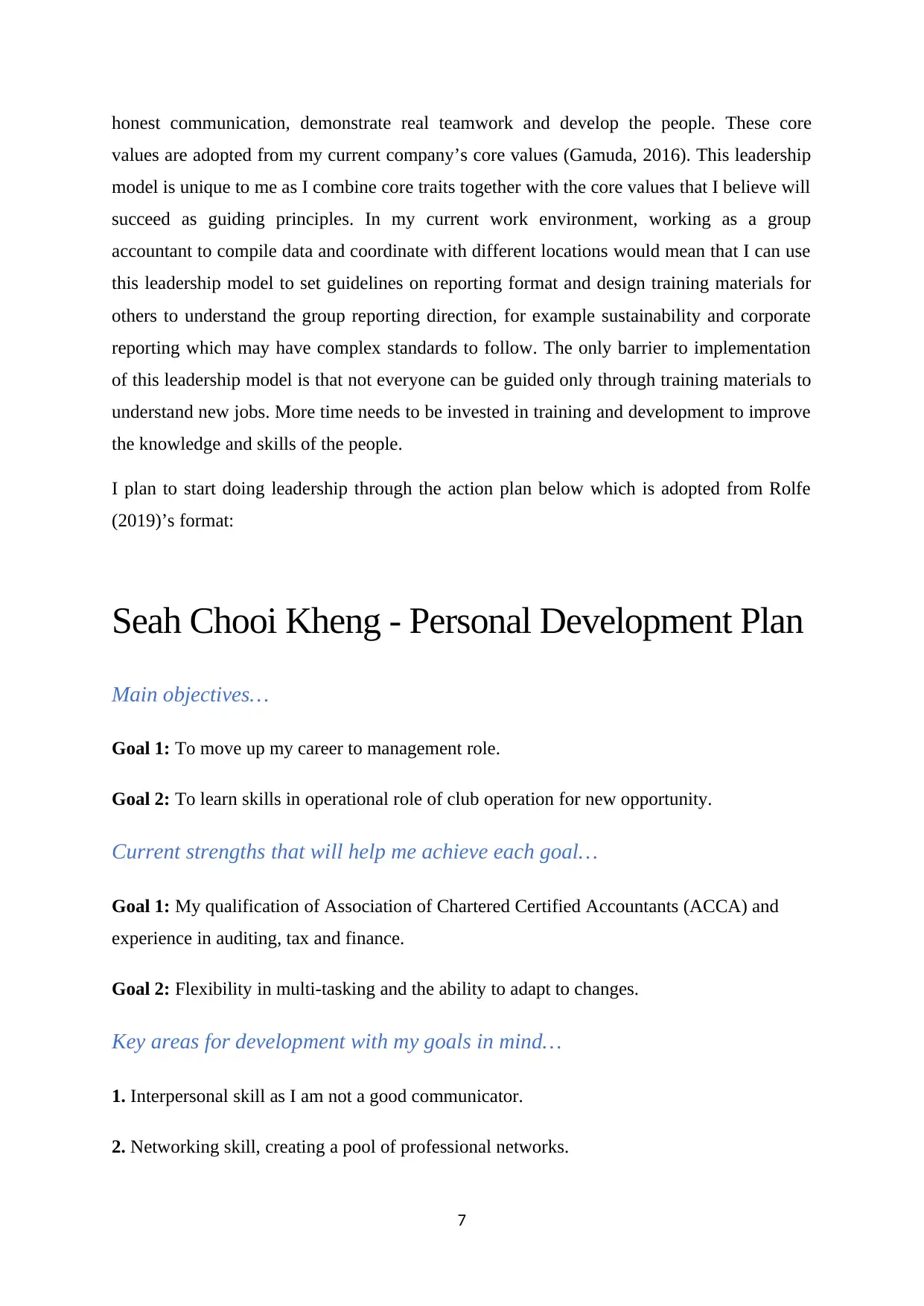
honest communication, demonstrate real teamwork and develop the people. These core
values are adopted from my current company’s core values (Gamuda, 2016). This leadership
model is unique to me as I combine core traits together with the core values that I believe will
succeed as guiding principles. In my current work environment, working as a group
accountant to compile data and coordinate with different locations would mean that I can use
this leadership model to set guidelines on reporting format and design training materials for
others to understand the group reporting direction, for example sustainability and corporate
reporting which may have complex standards to follow. The only barrier to implementation
of this leadership model is that not everyone can be guided only through training materials to
understand new jobs. More time needs to be invested in training and development to improve
the knowledge and skills of the people.
I plan to start doing leadership through the action plan below which is adopted from Rolfe
(2019)’s format:
Seah Chooi Kheng - Personal Development Plan
Main objectives…
Goal 1: To move up my career to management role.
Goal 2: To learn skills in operational role of club operation for new opportunity.
Current strengths that will help me achieve each goal…
Goal 1: My qualification of Association of Chartered Certified Accountants (ACCA) and
experience in auditing, tax and finance.
Goal 2: Flexibility in multi-tasking and the ability to adapt to changes.
Key areas for development with my goals in mind…
1. Interpersonal skill as I am not a good communicator.
2. Networking skill, creating a pool of professional networks.
7
values are adopted from my current company’s core values (Gamuda, 2016). This leadership
model is unique to me as I combine core traits together with the core values that I believe will
succeed as guiding principles. In my current work environment, working as a group
accountant to compile data and coordinate with different locations would mean that I can use
this leadership model to set guidelines on reporting format and design training materials for
others to understand the group reporting direction, for example sustainability and corporate
reporting which may have complex standards to follow. The only barrier to implementation
of this leadership model is that not everyone can be guided only through training materials to
understand new jobs. More time needs to be invested in training and development to improve
the knowledge and skills of the people.
I plan to start doing leadership through the action plan below which is adopted from Rolfe
(2019)’s format:
Seah Chooi Kheng - Personal Development Plan
Main objectives…
Goal 1: To move up my career to management role.
Goal 2: To learn skills in operational role of club operation for new opportunity.
Current strengths that will help me achieve each goal…
Goal 1: My qualification of Association of Chartered Certified Accountants (ACCA) and
experience in auditing, tax and finance.
Goal 2: Flexibility in multi-tasking and the ability to adapt to changes.
Key areas for development with my goals in mind…
1. Interpersonal skill as I am not a good communicator.
2. Networking skill, creating a pool of professional networks.
7
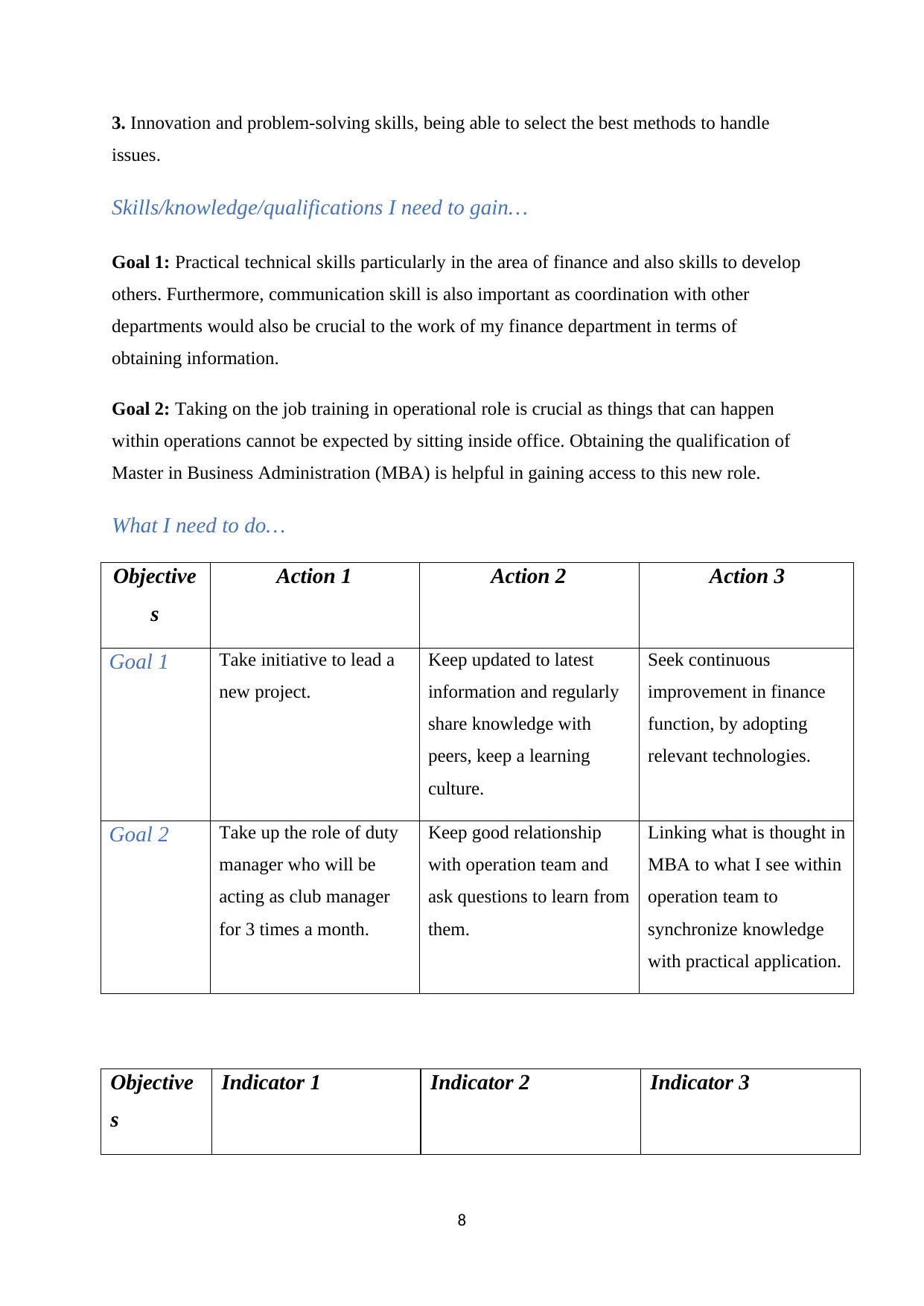
3. Innovation and problem-solving skills, being able to select the best methods to handle
issues.
Skills/knowledge/qualifications I need to gain…
Goal 1: Practical technical skills particularly in the area of finance and also skills to develop
others. Furthermore, communication skill is also important as coordination with other
departments would also be crucial to the work of my finance department in terms of
obtaining information.
Goal 2: Taking on the job training in operational role is crucial as things that can happen
within operations cannot be expected by sitting inside office. Obtaining the qualification of
Master in Business Administration (MBA) is helpful in gaining access to this new role.
What I need to do…
Objective
s
Action 1 Action 2 Action 3
Goal 1 Take initiative to lead a
new project.
Keep updated to latest
information and regularly
share knowledge with
peers, keep a learning
culture.
Seek continuous
improvement in finance
function, by adopting
relevant technologies.
Goal 2 Take up the role of duty
manager who will be
acting as club manager
for 3 times a month.
Keep good relationship
with operation team and
ask questions to learn from
them.
Linking what is thought in
MBA to what I see within
operation team to
synchronize knowledge
with practical application.
Objective
s
Indicator 1 Indicator 2 Indicator 3
8
issues.
Skills/knowledge/qualifications I need to gain…
Goal 1: Practical technical skills particularly in the area of finance and also skills to develop
others. Furthermore, communication skill is also important as coordination with other
departments would also be crucial to the work of my finance department in terms of
obtaining information.
Goal 2: Taking on the job training in operational role is crucial as things that can happen
within operations cannot be expected by sitting inside office. Obtaining the qualification of
Master in Business Administration (MBA) is helpful in gaining access to this new role.
What I need to do…
Objective
s
Action 1 Action 2 Action 3
Goal 1 Take initiative to lead a
new project.
Keep updated to latest
information and regularly
share knowledge with
peers, keep a learning
culture.
Seek continuous
improvement in finance
function, by adopting
relevant technologies.
Goal 2 Take up the role of duty
manager who will be
acting as club manager
for 3 times a month.
Keep good relationship
with operation team and
ask questions to learn from
them.
Linking what is thought in
MBA to what I see within
operation team to
synchronize knowledge
with practical application.
Objective
s
Indicator 1 Indicator 2 Indicator 3
8
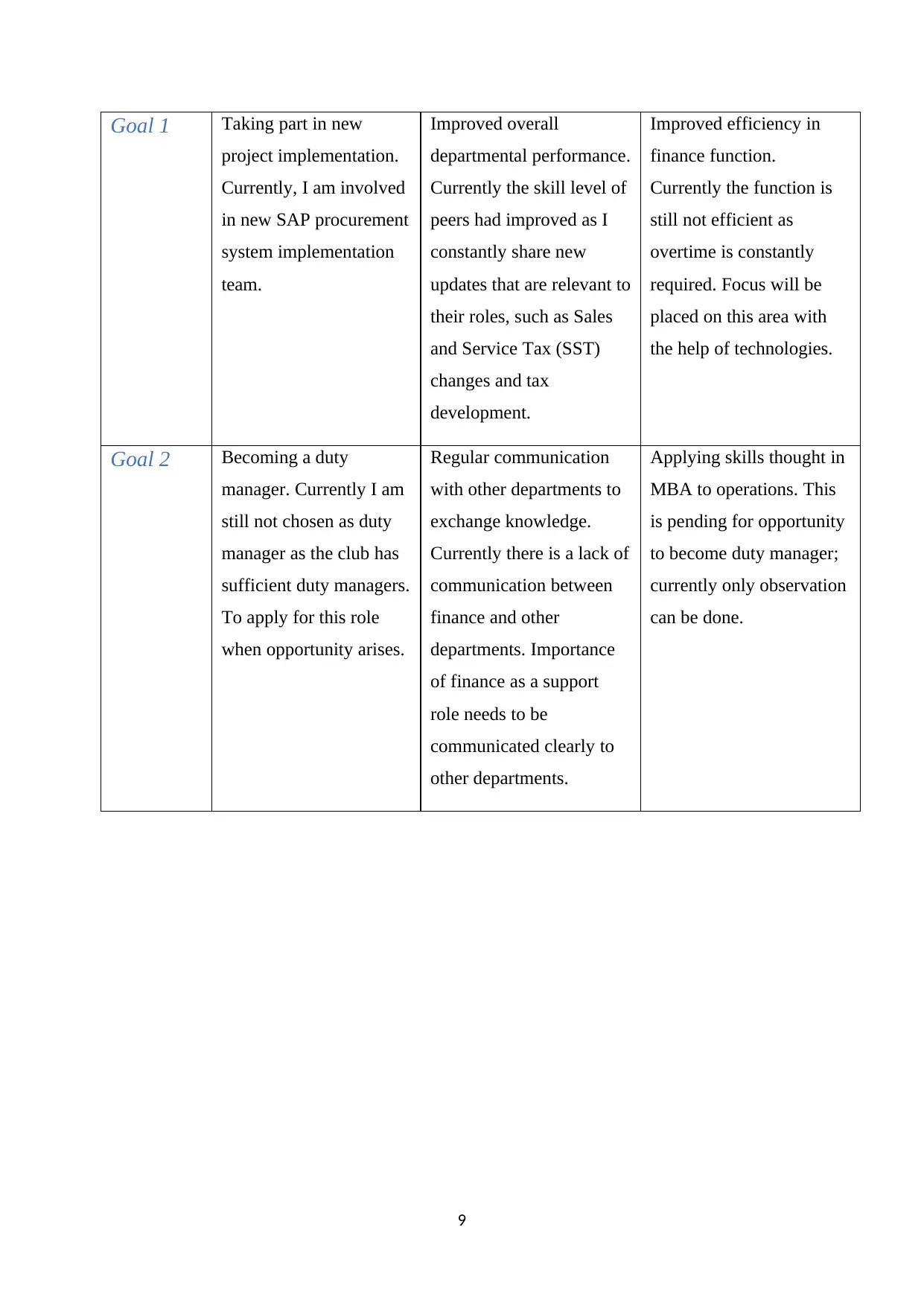
Goal 1 Taking part in new
project implementation.
Currently, I am involved
in new SAP procurement
system implementation
team.
Improved overall
departmental performance.
Currently the skill level of
peers had improved as I
constantly share new
updates that are relevant to
their roles, such as Sales
and Service Tax (SST)
changes and tax
development.
Improved efficiency in
finance function.
Currently the function is
still not efficient as
overtime is constantly
required. Focus will be
placed on this area with
the help of technologies.
Goal 2 Becoming a duty
manager. Currently I am
still not chosen as duty
manager as the club has
sufficient duty managers.
To apply for this role
when opportunity arises.
Regular communication
with other departments to
exchange knowledge.
Currently there is a lack of
communication between
finance and other
departments. Importance
of finance as a support
role needs to be
communicated clearly to
other departments.
Applying skills thought in
MBA to operations. This
is pending for opportunity
to become duty manager;
currently only observation
can be done.
9
project implementation.
Currently, I am involved
in new SAP procurement
system implementation
team.
Improved overall
departmental performance.
Currently the skill level of
peers had improved as I
constantly share new
updates that are relevant to
their roles, such as Sales
and Service Tax (SST)
changes and tax
development.
Improved efficiency in
finance function.
Currently the function is
still not efficient as
overtime is constantly
required. Focus will be
placed on this area with
the help of technologies.
Goal 2 Becoming a duty
manager. Currently I am
still not chosen as duty
manager as the club has
sufficient duty managers.
To apply for this role
when opportunity arises.
Regular communication
with other departments to
exchange knowledge.
Currently there is a lack of
communication between
finance and other
departments. Importance
of finance as a support
role needs to be
communicated clearly to
other departments.
Applying skills thought in
MBA to operations. This
is pending for opportunity
to become duty manager;
currently only observation
can be done.
9
Secure Best Marks with AI Grader
Need help grading? Try our AI Grader for instant feedback on your assignments.
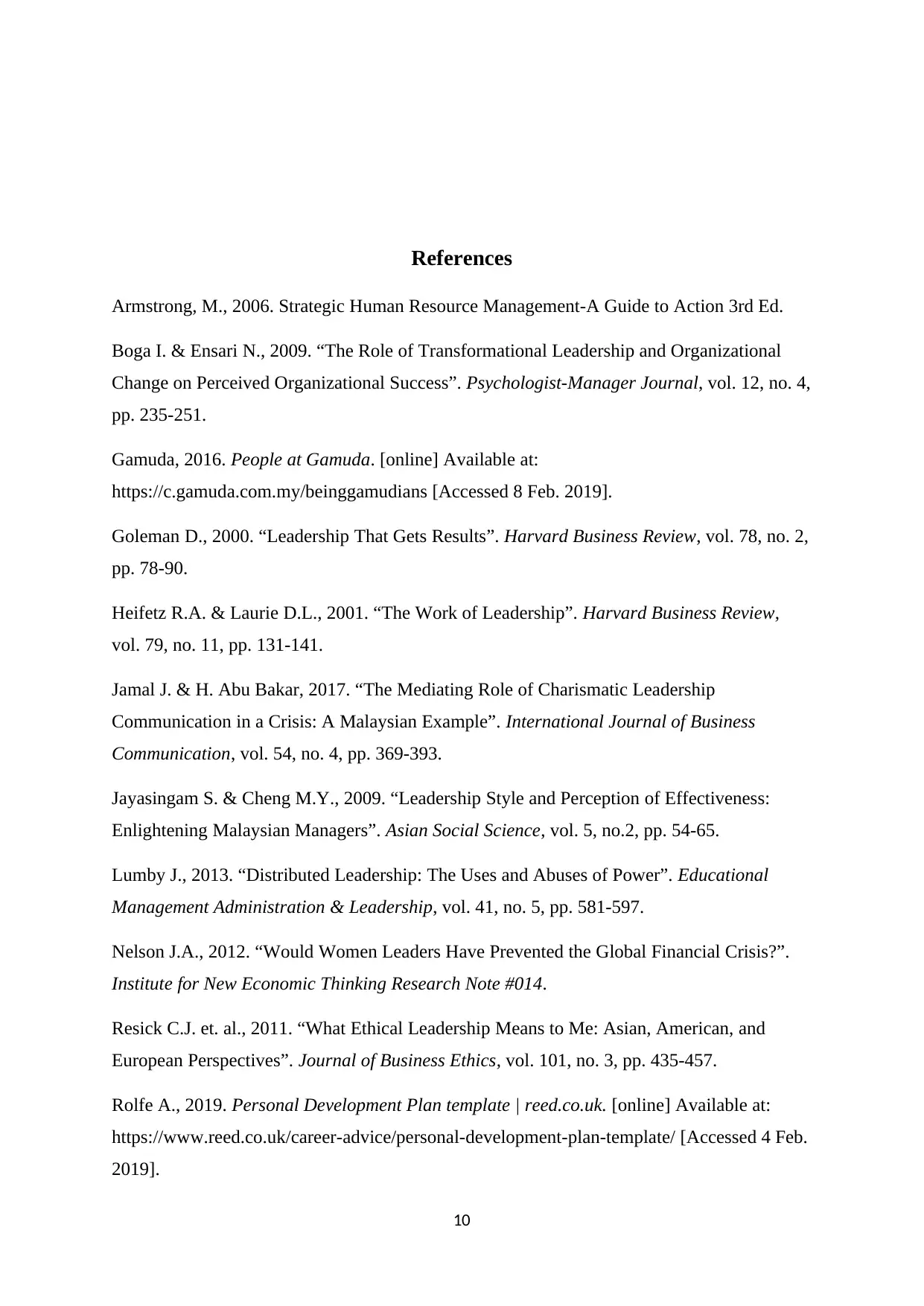
References
Armstrong, M., 2006. Strategic Human Resource Management-A Guide to Action 3rd Ed.
Boga I. & Ensari N., 2009. “The Role of Transformational Leadership and Organizational
Change on Perceived Organizational Success”. Psychologist-Manager Journal, vol. 12, no. 4,
pp. 235-251.
Gamuda, 2016. People at Gamuda. [online] Available at:
https://c.gamuda.com.my/beinggamudians [Accessed 8 Feb. 2019].
Goleman D., 2000. “Leadership That Gets Results”. Harvard Business Review, vol. 78, no. 2,
pp. 78-90.
Heifetz R.A. & Laurie D.L., 2001. “The Work of Leadership”. Harvard Business Review,
vol. 79, no. 11, pp. 131-141.
Jamal J. & H. Abu Bakar, 2017. “The Mediating Role of Charismatic Leadership
Communication in a Crisis: A Malaysian Example”. International Journal of Business
Communication, vol. 54, no. 4, pp. 369-393.
Jayasingam S. & Cheng M.Y., 2009. “Leadership Style and Perception of Effectiveness:
Enlightening Malaysian Managers”. Asian Social Science, vol. 5, no.2, pp. 54-65.
Lumby J., 2013. “Distributed Leadership: The Uses and Abuses of Power”. Educational
Management Administration & Leadership, vol. 41, no. 5, pp. 581-597.
Nelson J.A., 2012. “Would Women Leaders Have Prevented the Global Financial Crisis?”.
Institute for New Economic Thinking Research Note #014.
Resick C.J. et. al., 2011. “What Ethical Leadership Means to Me: Asian, American, and
European Perspectives”. Journal of Business Ethics, vol. 101, no. 3, pp. 435-457.
Rolfe A., 2019. Personal Development Plan template | reed.co.uk. [online] Available at:
https://www.reed.co.uk/career-advice/personal-development-plan-template/ [Accessed 4 Feb.
2019].
10
Armstrong, M., 2006. Strategic Human Resource Management-A Guide to Action 3rd Ed.
Boga I. & Ensari N., 2009. “The Role of Transformational Leadership and Organizational
Change on Perceived Organizational Success”. Psychologist-Manager Journal, vol. 12, no. 4,
pp. 235-251.
Gamuda, 2016. People at Gamuda. [online] Available at:
https://c.gamuda.com.my/beinggamudians [Accessed 8 Feb. 2019].
Goleman D., 2000. “Leadership That Gets Results”. Harvard Business Review, vol. 78, no. 2,
pp. 78-90.
Heifetz R.A. & Laurie D.L., 2001. “The Work of Leadership”. Harvard Business Review,
vol. 79, no. 11, pp. 131-141.
Jamal J. & H. Abu Bakar, 2017. “The Mediating Role of Charismatic Leadership
Communication in a Crisis: A Malaysian Example”. International Journal of Business
Communication, vol. 54, no. 4, pp. 369-393.
Jayasingam S. & Cheng M.Y., 2009. “Leadership Style and Perception of Effectiveness:
Enlightening Malaysian Managers”. Asian Social Science, vol. 5, no.2, pp. 54-65.
Lumby J., 2013. “Distributed Leadership: The Uses and Abuses of Power”. Educational
Management Administration & Leadership, vol. 41, no. 5, pp. 581-597.
Nelson J.A., 2012. “Would Women Leaders Have Prevented the Global Financial Crisis?”.
Institute for New Economic Thinking Research Note #014.
Resick C.J. et. al., 2011. “What Ethical Leadership Means to Me: Asian, American, and
European Perspectives”. Journal of Business Ethics, vol. 101, no. 3, pp. 435-457.
Rolfe A., 2019. Personal Development Plan template | reed.co.uk. [online] Available at:
https://www.reed.co.uk/career-advice/personal-development-plan-template/ [Accessed 4 Feb.
2019].
10
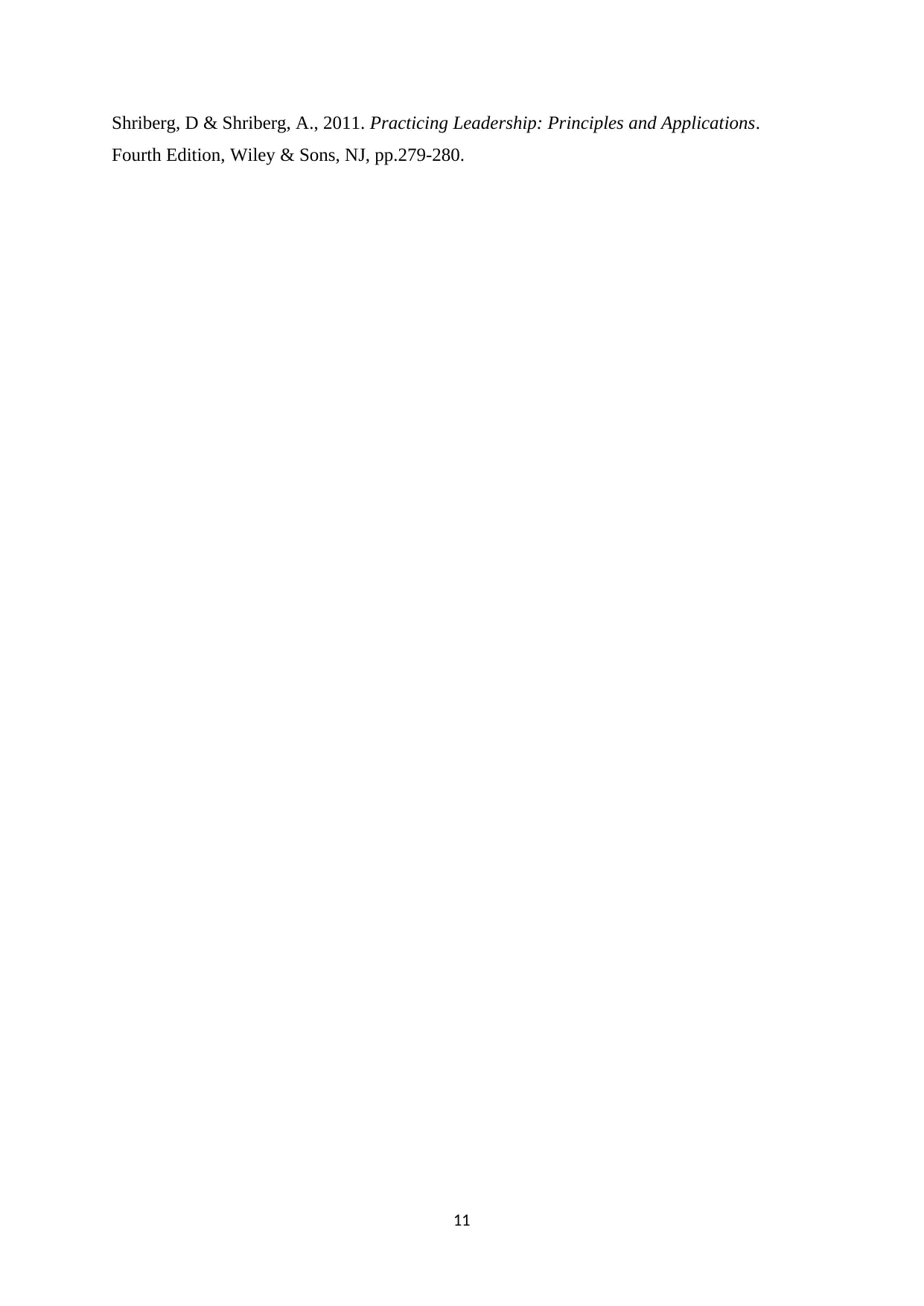
Shriberg, D & Shriberg, A., 2011. Practicing Leadership: Principles and Applications.
Fourth Edition, Wiley & Sons, NJ, pp.279-280.
11
Fourth Edition, Wiley & Sons, NJ, pp.279-280.
11
1 out of 12
Related Documents
Your All-in-One AI-Powered Toolkit for Academic Success.
+13062052269
info@desklib.com
Available 24*7 on WhatsApp / Email
![[object Object]](/_next/static/media/star-bottom.7253800d.svg)
Unlock your academic potential
© 2024 | Zucol Services PVT LTD | All rights reserved.





